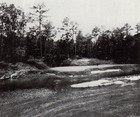Rain Delay Flashback: 1937 and Perry Maxwell
/Courtesy of reader Michael...
AUGUSTA COURSE TO HAVE FACE LIFTED FOR MASTERS' TOURNEY
By Charles Bartlett, Chicago Tribune, Sunday, January 23, 1938
Major league golfers who have been swinging clubs for the last four years in the annual Masters' tournament at Augusta, Ga., which brings a man named Bobby Jones back for his single yearly appearance as a competitor, are going to do a bit of eyebrow raising and glove flexing when they step upon the first tee for the fifth all-star show there, beginning March 31 and ending April 2.

(click to enlarge) The reason for their concern may now be called work in progress. It consists of transforming the course from its original Scotch motif to one more adapted to the American topography upon which it was constructed. No official announcement of the revisions has been made, but the presence of a sharp eyed little Oklahoman named Perry Maxwell on the Augusta National course these last few months would indicate that the lads will find a new layout when they set forth in quest of the $1,500 first prize.
Mr. Maxwell is a livestock farmer who, in his spare moments, has become one of the nation's leading golf architects. He has been assigned the chore of making the Augusta National acreage an American course rather than the overseas composite layout it was intended to be when the late Dr. McAllister McKenzie, and Jones himself collaborated on making it a replica of the more famed seaside links.
Principal changes in the National course will be in the vicinity of the greens. It was around these that the original sketches aimed to reproduce the foreign touch of St. Andrews, Muirfield, and other noted courses. Four years of competition have proved that while the experiment may have been a worthwhile effort as such, the lovely Georgia countryside is not adapted to it. The quarter mile arch of century old magnolias, leading to the antebellum clubhouse, are only a preface to the wistaria and dogwood with which the course abounds. Attempting to duplicate the austere Scottish coast line, where the early morning mist makes it difficult to distinguish the rolling sand dunes from the gray of the North Sea, is a feat not in tune with the terrain at Augusta. The abruptness of the dunes contours, which frequently caused well-hit approach shots to kick awry, has been done away with. So also have the peculiar undulations in the ground adjacent to the greens been reduced, although at no sacrifice to testing a shot.
(click to enlarge)
The greens at the fifth, seventh and seventeenth holes have been rebult, and an entirely new tenth green has been cut into the hillside behind and at the left of the original green, on high ground. The hole has been lengthened to 449 yards, and is a fine two-shot test for the experts. P.J.A. Berchman, the horticulturist who was born on the site of the course and who has been resonsible for its general beautification, has removed seventy-five pine trees to make way for the new tenth. The change has been made not to eliminate any peculiarity in land formation, calling for what was at best a freakish second shot, but to try a player's ability to hit a long ball to a well built-up modern green. The green proper is the largest on the lot, and will call for precise approach putting.
Not all of the old country features have been eliminated. The "schoolmaster's nose" bunker in the middle of the eleventh fairway, built to duplicate one of old St. Andrews' most notorious sand pits, is still there. It remains the same as it was on that day when Col. Bob Jones (father of Bobby) hit a good drive into it, and was moved to inquire, "What jackass dug that in the middle of the pretty?"











